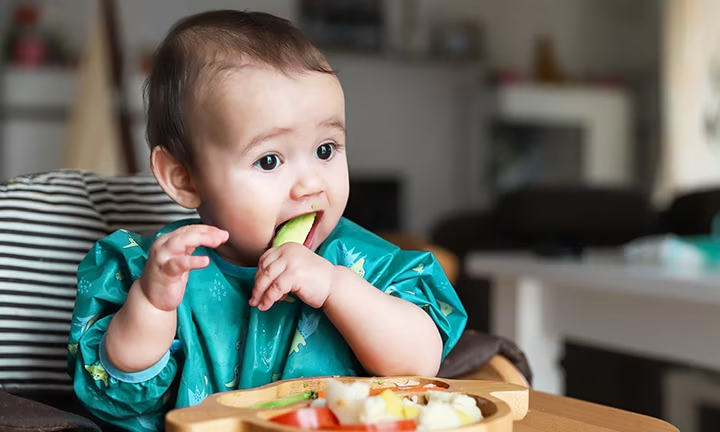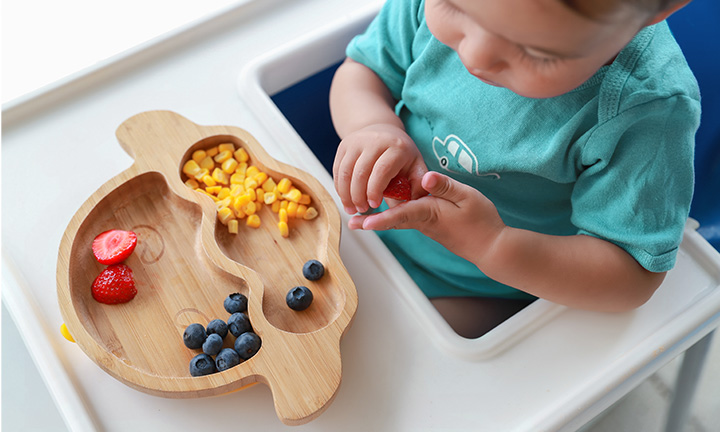
What Is Baby-Led Weaning?
Is your little one ready to transition to solid foods? If so, it’s time for them to explore new foods and get messy! If you are looking for an alternative to spoon-feeding and jars of baby food, you may want to consider baby-led weaning. Baby-led weaning is a method in which babies begin feeding themselves with finger foods from the start. Read on to find out more about baby-led weaning, some first food ideas, and if baby-led weaning is right for you and your little one.
What Is Baby-Led Weaning (BLW)?
Baby-led weaning, abbreviated as BLW, is when your baby of 6 months or older feeds themselves with finger foods rather than being spoon-fed. The idea behind the BLW method is that it allows your baby to explore foods with different textures, as well as self-regulate the amount of food they’d like to eat. Traditionally, when introducing solids parents begin spoon-feeding their infants from around 6 months of age with pureed foods. Gradually, parents expand their baby’s menu to include foods with coarser textures, such as mashed and chopped foods, served with a spoon, and then finger foods. Finally, babies are introduced to family foods (the same foods eaten by the entire family at mealtime) when they’re about 12 months old.
In Summary
Baby-led weaning is a way of introducing solid foods to your baby that is an alternative to the traditional method of spoon-feeding. In this method, babies begin feeding themselves solid food with their hands instead of being fed purees with a spoon.
Benefits of Baby-Led Weaning
The main principle of baby-led weaning is allowing babies to guide the food into their mouths on their own. This method replaces spoon-feeding, where you as the parent may need to pretend that the spoon is a rocket, an airplane, or a train in order to get your little one to take a bite. Some research has shown that BLW has many benefits for babies, including
Risks and/or Disadvantages of Baby-Led Weaning
As with spoon-feeding your baby, you’ll need to ensure that your little one is getting the proper amount of iron in their diet, as this (along with other nutrients) is essential for healthy growth and development. When allowing your little one to feed themselves, you may encounter a bit of a mess. Your baby will enjoy picking and choosing what they want and don’t want to eat, resulting in plenty of food thrown on the floor. But that’s all part of the fun! If you’re considering baby-led weaning, check in with your child’s health visitor to weigh the risk factors together and decide whether it is a good choice for you and your baby.
Choking
The chief concern when it comes to baby-lead weaning is the possibility of choking. As your baby is learning to eat, they’ll move food around in their mouth, biting and attempting to chew whether they have baby teeth or not, and there is a possibility of choking. However, studies have suggested that if parents take the right precautions, baby-led weaning is just as safe as spoon-feeding as a way of introducing solid foods. Always supervise your child during self-feeding. Ensure your child is seated upright and don’t leave them unattended. Offer your little one foods that are easy for them to pick up, and easily mashable in their mouth, soften any hard fruit and vegetables, and cut any small, round food in half, such as grapes and cherry tomatoes.
Foods High in Salt and Sugar
When introducing your little one to solid foods during the weaning stage (from 6 months old until about 1 to 2 years of age), don’t offer them food that is heavily salted, sweetened, spiced or high in fat. These additives can disguise the natural taste of different foods and could have long-term, harmful effects on your baby’s health. Keep this in mind as you plan and prepare meals and as your little one begins to eat food from the family table, as many processed foods are high in sodium and/or sugar.
In Summary
As with spoon-feeding, the baby-led weaning method of introducing solid foods to your baby requires supervising your child to prevent possible risks, such as choking. It’s also important to avoid foods with sugar, salt and high fat content. Discuss the pros and cons of this method with your health visitor and determine whether it’s the right fit for your baby.
When and How to Start Baby-Led Weaning
You can start baby-led weaning when you would typically introduce solid foods, which is around 6 months of age. This is usually when spoon-feeding with solid foods (pureed and mashed foods) would take place. However, if you’ve chosen to try baby-led weaning, you’d skip spoon-feeding and start directly with finger foods cooked to a soft texture and cut into strips (more on this in the next section). Around 6 months is recommended as the ideal time to introduce solid foods as a complement to breastfeeding or formula feeding because it’s around the time your baby
Whether you choose spoon-feeding or baby-led weaning, you should exclusively breastfeed (or bottle-feed) until 6 months of age. After that, you can start introducing complementary foods while continuing breastfeeding or formula feeding for as long as it suits both you and your baby.
In Summary
You may start baby-led weaning at around 6 months of age, which is also the age you would traditionally introduce complementary foods via spoon-feeding. At this age, your baby will most likely be able to sit unsupported, bring food to their mouth, and chew and swallow – all things that are important for self-feeding.
First Foods for Baby-Led Weaning
If you’re thinking about trying baby-led-weaning with your 6-month-old, here are some of the best first foods to try:
With baby-led weaning you’ll want to offer food shapes and sizes that are easy for your infant to hold, so opt for cutting most things into sticks or strips about the length of your finger. For example, offer a floret of steamed broccoli, a steamed carrot stick, or a small strip of soft-cooked chicken. A handy tip: You know it’s the right size if there’s a bit of the food protruding from your baby’s fist when holding it. Avoid offering foods that are hard, small, coin-shaped, slippery, crunchy, sticky, or tough to chew. These types of foods can lead to choking. Also, remember to allow any cooked food to cool down before giving it to your baby. Basically, most of the foods you’d offer your baby as part of spoon-feeding can also be offered as part of baby-led weaning. Baby-led weaning may be simpler than spoon-feeding from jarred baby food since you can give your baby many of the same foods as you’re feeding your family. However, it’s important that the foods not be salted, sweetened, or seasoned and that they are healthy and nutritious. You may consider making some homemade baby food or you may have to adapt your cooking style during this time to incorporate some baby-led weaning recipes.
In Summary
You can introduce the same types of food to your baby with baby-led weaning as with spoon-feeding. The difference is you’ll want to slice most foods into stick-like shapes about the size of your finger so that your baby can pick them up. Make sure meat and vegetables are cooked through and soft before cooling them to a safe temperature for your baby.
FAQS AT A GLANCE
You can start baby-led weaning when your baby turns 6 months old, which is the same time you would start the more traditional method of spoon-feeding. This is the age at which your baby most likely can sit up on their own, bring food to their mouth and independently eat their food.
The Bottom Line
Baby-led weaning is an alternative method to spoon-feeding when it comes to introducing your baby to solid foods at around 6 months of age. With this method, your baby feeds themself with foods cut into sticks or strips no bigger than your finger. This method of self-feeding encourages your baby to be independent and allows them to make decisions, such as how much to eat and when to stop eating once full. Other benefits may include your baby being less fussy or demanding about eating, a lesser chance of overeating, and the opportunity to eat the same foods as the rest of the family from the get-go. Studies have shown that the risk of choking with baby-led weaning is no different than with spoon-feeding. However, if you’re providing the same foods for your baby as the rest of your family, make sure that your baby’s portion isn’t salted, seasoned, or sweetened. If you’re thinking of trying baby-led weaning instead of the more traditional route of spoon-feeding your little one, speak to your child’s health visitor for more advice. Weigh the pros and cons together and decide whether this method of self-feeding is right for you and your baby. And remember, have fun as your little one explores new textures and flavours and makes a lovely mess!
Read more about Baby
Related Articles
Join Pampers Club and get:








